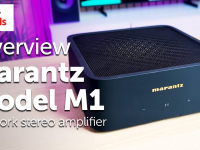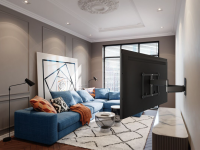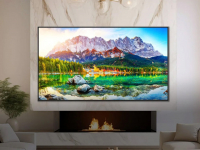Regular readers of the Tech Blog will recall our recent announcement regarding the new Cambridge Audio ‘CX’ series of components. This all-new for 2015 range of A/V and Hi-Fi separates is already looking to be something special, but is still a little way off completion, and we expect it into our stores this coming March.
Being the lovely people that they are, Cambridge were kind enough to let me take part in their ‘Beta’ testing for some of the new range. Needless to say, I was delighted to be asked and, being the Hi-Fi nut that I am, was even more delighted to find out I’d be spending some quality time with the CXA80 stereo amplifier, and CXN network receiver. If it wasn’t February I’d swear it was Christmas!
The Equipment
A short time after I’d first liaised with them, my two ‘samples’ were delivered to the store, and immediately dug out of their packaging. First impressions are key, and for pre-release samples, the Cambridge duo were looking mighty fine indeed. Sat atop their elegant ‘floating’ front plinth, the CX series look every bit a premium product. The new casework and fascia layout seems a natural evolution from both their 651 and flagship 851 ranges, taking design cues from both, but giving even greater focus to practicality and ergonomics.
Starting with the CXA80, Cambridge’s industrial design team have excelled themselves in attaining such a well balanced front end. The input select buttons are placed in a symmetrical pattern along the centre of the amp. Buttons are separated by type, with the left hand side dedicated to analogue inputs, and the right hand side for its suite of digital inputs. The three central buttons are for speaker select (two pairs can be driven, both individually and together), audio direct, which takes the bass, treble and balance dials out of the equation, and finally, a mute button. A headphone output is provided, as is a 3.5mm line input for those whose mobile devices lack Bluetooth. Those wishing to use the Bluetooth option will need to pick up Cambridge’s ‘BT100’ receiver, also.
Unusually for a stereo amplifier, the CXA80 comes equipped with two lots of inputs for optical connections, and a digital coaxial, too. Their inclusion here represents a fairly seismic shift in thinking for traditional 2-channel amplifiers, and lends itself well to Cambridge‘s ethos for the series as a whole. Plenty of people these days have heard huge benefits when running their TV into a dedicated audio system. As thin as they’ve become, modern televisions are incapable of giving great sound, and their standard audio output, the optical connection, has been something of a rarity on Hi-Fi amplifiers. Including them here, then, is a huge plus. Those whose set features a digital coaxial are taken care of, too.
Rounding off the unusual inputs is an extremely handy USB-B connection, allowing the direct connection of a Mac, PC or laptop. For people like myself with a huge quantity of music backed up digitally, this is a great, one-box solution for getting the most out of this library. For those whose music is stored somewhere else in the house, say a NAS drive for example, the CXA80‘s partner in crime today is going to be right up their street!
The CXN is effectively the replacement for Cambridge‘s award winning Stream Magic 6 network player. Being based on a hugely influential predecessor, the CXN doesn’t rip up the rule book and start again from scratch – but the changes that have been made have made an award winner even greater. Immediately noticeable amongst these upgrades is the large, full colour display. Gone is the old monochrome screen, replaced by this new, suave 4.3″ LCD. From my seat in our demonstration room, the new display was easily readable, and made setting up and navigating a breeze. With wholesale changes made to the CXN‘s operating system to accommodate this new screen, I was wary that the new streamer would fall into the trap of having too little on-board processing power, and that the responsiveness of the menus and touch wheel would suffer. Fortunately, my fears were immediately allayed! The CXN’s jog wheel was a joy to use, giving me super-responsive feedback as soon as the dial was moved.
Back into the technical side of things, the CXN‘s streaming capabilities have been upgraded since the StreamMagic 6. Spotify Connect is now featured, so alongside the Airplay and Bluetooth connectivity, and also the inbuilt Internet radio tuner, there really isn’t much that this latest streamer can’t grab music from. Dual Wolfson Digital-to-Analogue converters are on hand to maximise the potential the CXN can offer to an ageing system, providing extra inputs on the rear for connecting digital devices that can then piggyback off the high quality audio processing inside. This is a particularly nice feature! Music files can be played in up to 24/192khz bit-rates, and the aforementioned processing can digitally up-sample this to a whopping 24/384khz!
More than ready for a listen at this point, the CXN was quickly added to our in-store Wi-Fi network and we were up and running in no time. A variety of speakers were used over the course of the session, including Dali’s Ikon 6, KEF’s Q500 and Cambridge‘s own Aero 6. The latter were kept in situ, and the brand-synergy gave us our best configuration. Music time!
The Music
 Bob Dylan‘s (in)famous Live at the Royal Albert Hall set is part of the much-praised Bootleg Series from Columbia Records. The record was actually recorded live at the Manchester Free Trade Hall, having been labelled incorrectly by bootleggers during its initial, illicit release. The first half of the 2-disc set is Dylan at his acoustic finest, playing then-new songs (Blonde on Blonde‘s 4th Time Around, Just Like A Woman and Visions of Johanna all appear) and other soon-to-be classics all by his lonesome. The second disc is home to music’s most famous heckler, as a disgruntled fan, infuriated by Dylan‘s reappearance post-interval with The Hawks – soon to be The Band – cries out ‘Judas!’, receiving a round of applause louder than The Hawks would hear all tour.
Bob Dylan‘s (in)famous Live at the Royal Albert Hall set is part of the much-praised Bootleg Series from Columbia Records. The record was actually recorded live at the Manchester Free Trade Hall, having been labelled incorrectly by bootleggers during its initial, illicit release. The first half of the 2-disc set is Dylan at his acoustic finest, playing then-new songs (Blonde on Blonde‘s 4th Time Around, Just Like A Woman and Visions of Johanna all appear) and other soon-to-be classics all by his lonesome. The second disc is home to music’s most famous heckler, as a disgruntled fan, infuriated by Dylan‘s reappearance post-interval with The Hawks – soon to be The Band – cries out ‘Judas!’, receiving a round of applause louder than The Hawks would hear all tour.
So, acoustic set first, and the Cambridge breathed life into the tracks, really giving the acoustics of the hall a proper showing. Dylan‘s vitriol, his disdain almost, when singing some of his lyrics comes across razor sharp – this is a man who wants the second half of his set to begin! I’ve heard the album a hundred times, but the Cambridge had me right back in the moment again. The often shrill harmonica, close-mic’d as it is, was kept in check but was as emotive as ever. The second set was as electrifying as promised by the man himself. It’s not always a pleasant listen on some systems.
 I’ve heard it sound harsh, shouty and tinny. Here, it was sounding full and well-rounded; Like A Rolling Stone sounded positively bombastic, with everyone turned up to 11 for the finale to the show, Dylan and the band stirred up even more by the aforementioned verbal dressing down. The rendition was marvellously musical and was brilliant fun to listen to. Next!
I’ve heard it sound harsh, shouty and tinny. Here, it was sounding full and well-rounded; Like A Rolling Stone sounded positively bombastic, with everyone turned up to 11 for the finale to the show, Dylan and the band stirred up even more by the aforementioned verbal dressing down. The rendition was marvellously musical and was brilliant fun to listen to. Next!
Lesser known amongst the back catalogue of (Sir) Paul McCartney is his work with the producer Youth (The Orb) as The Fireman. Their 1998 release Rushes is easily my most prized (and expensive!) CD. A wonderfully produced work of ambient electronica, found-sounds and instrumentation performed by McCartney, its rarity only adds to the mysterious air of the songs. The album’s tracks segue from one to the next, and build on repeating themes, almost like a suite. Opening track Watercolour Guitars is a display of McCartney’s fine fingerpicking, backed by Reich-esque chord fragments that fade in and out of mix. The Cambridge combo gave real insight into the ethereal noodlings of Youth’s production, and gave McCartney’s dream-like playing a solid mooring within the producer’s widescreen soundscape. All eight tracks had soon flown by, and I was happily listening away, my notes soon cast aside.
Dynamically, the CX were able to shift things about on an absolute knife-edge when required. It’s not music for the feint of heart, but Squarepusher‘s Do You Know Squarepusher from the album of the same name has more going on in its 5:06 running than most full albums do in 10 times that length. Skittering drum patterns, weighty bass drops and hugely skewered vocals all feature, and the demonstration room was quickly devoid of my colleagues! I however, was in Heaven, the Cambridge wrestling the track into submission as my grip on the volume control lead me further and further into anti-social listening levels. Impressed was an understatement!
The Verdict
So then, time for a summary of the two? The CRX80 is a bold and hugely confident performer, capable of handling huge dynamic shifts and transients. Its ability to grip on to all aspects of the music, creating a wonderfully cohesive sound, was captivating, and left me glued to my seat throughout my listening session. The CXN was a joy to work with, its easy to use and intuitive layout made navigating my favourite music a breeze, and most importantly, the sound quality on show from the new streamer was superlative itself.
If this is a sign of things to come, then Cambridge have got something very special for us all this year. Roll on, March!
Shop for Cambridge Audio with Richer Sounds now.
Author: Chris, Liverpool store












Interesting reading, your review of the CRX. I am though a bit concerned though, being a former classical music professional, that it has not been tested for the much wider dynamic range and orchestral instrumental clarity I would need when listening to this music. e.g. Holst: The Planets, Prokofiev: first piano concerto or a Shostakovich symphony. Why do you use only ‘pop’ music for these tests?
In my experience over 50 years, if equipment can deal adequately with a wide range of classical music it will deal well with any ‘pop’ music.
Ray Stamford (VIP) Cambridge
Hi Ray,
Thanks for the feedback! My tastes range quite dramatically across a number of genres, from the ones listed above and include both modern and traditional classical music. That being said, during my review time, a number of different albums and pieces were chosen for listening, and as reviews need to be kept to a certain length, I had to choose which of the tracks used stood out to me as being particularly good.
Hopefully, if you do get the chance to see this (apologies for the late reply!) you’ll by now have the chance to audition the CX series for yourself, which ultimately will give you the best idea of how your own tastes in music are reflected by the kit itself.
For what it’s worth, I’m confident that scale should be no issue for the CXA80, and that clarity and separation, even in larger pieces, should be some of the best in class.
Happy listening!
-Chris, Liverpool